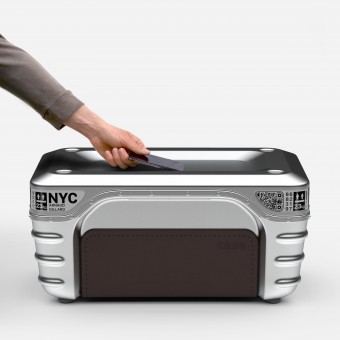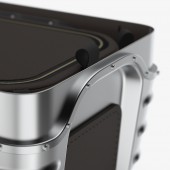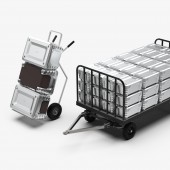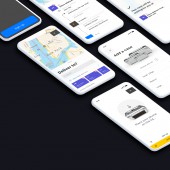Case Luggage Travelling Separately by Arnaud Gillard |
Home > Winners > #106491 |
 |
|
||||
| DESIGN DETAILS | |||||
| DESIGN NAME: Case PRIMARY FUNCTION: Luggage Travelling Separately INSPIRATION: Travelling with luggage is a stressful and arduous experience for both the traveller themselves and the infrastructure built to accommodate it. When envisioning the future of mobility, very few imagine a future where we continue to drag our belongings along with us. Through in-depth research with key stakeholders in the mobility, logistics and luggage industry it was established that the most appropriate solution is a disruptive solution aimed at truly divesting luggage from the traveller. UNIQUE PROPERTIES / PROJECT DESCRIPTION: Case envisions the future of luggage and how luggage might evolve to become something that travels separately from its owner. Streamlining the travel experience, reducing stress, whilst also minimizing costly infrastructure. The 'Case' is provided to you as part of an on-demand service whereby it will be delivered from your home to your destination ahead of the traveler, replacing the need to own and travel with luggage. OPERATION / FLOW / INTERACTION: Once an empty Case is delivered to the user's home, the user places their phone on its lid and unlocks it using the case.travel app. The user then packs their belongings in the case locking it up by simply placing the lid back on. The app is then used to update the tech with travel details. Once the Case is in transit, the traveler may then choose to travel with whichever transport suits them best. Upon arrival, the traveler will find their case waiting for them in their room. PROJECT DURATION AND LOCATION: This project started in October 2019 in Loughborough and finished in June 2020 in Amsterdam. |
PRODUCTION / REALIZATION TECHNOLOGY: The Case primarily constitutes a hydroformed aluminium unibody aimed at providing ample strength to weight ratio, whilst ensuring full recyclability at the end of life. It leverages technologies such as RFID, E-ink displays, electric locks and digital scales to provide the best travel experience. All without the need for an internal battery, thanks to its two-way wireless charging compatibility. In-depth research, combined with design thinking workshops helped established a detailed service blueprint, whilst many iterations of UX/UI wireframes established the app interface. SPECIFICATIONS / TECHNICAL PROPERTIES: Unlike traditional luggage, the dimensions of Case is standardised and optimised for use across the logistics industry. Improving handling efficiency, reliability, and cutting costs. The Case itself measures at 380mm x 580mm x 270mm (58 Litres). Comfortably storing enough items for a 2-4 day trip. Users are able to order multiple Cases to their desired needs. An optimised design also allows for an earlier delivery time, ensuring that the traveller's belongings will always arrive before the traveller. As the number of adopters increases, the cost of transporting the Case willdecrease drasticallyand beneutralizedby the saving of the transportation industry. It is expected thatat some point, given the economic forces at play, it will becheaperto have a user's Case travel separately that to travel with it. TAGS: Logistics, Mobility, Luggage, Suitcase, Service Design, UX Design, Industrial Design, Infrastructure, Future travel, Luggage-free RESEARCH ABSTRACT: The complexity of the project was distilled using a mix of core design research practices. Knowledge of the logistics and travel industry were gathered through attending Webinars, Conferences, interviewing industry specialists, referencing official literature, and conducting competitor analysis. Whilst user-driven insights were obtained through scenario mapping, role-playing, ergonomic testing, and user evaluations. CHALLENGE: A major challenge was establishing if the product should be owned by the user, or provided as part of the service. Each with their own challenges. It was decided that having the product provided as part of the service enabled a better user experience. Another difficulty was the very tight specifications set for the project. It needed to be lightweight, durable, technologically enabled, and optimised for the logistics industry. Meaning each design change consequently altered many other elements. ADDED DATE: 2020-06-07 08:15:38 TEAM MEMBERS (1) : Samsonite, IAG Cargo, European Platform on Sustainable Urban Mobility plans, Loughborough University IMAGE CREDITS: Arnaud Gillard, 2020. |
||||
| Visit the following page to learn more: http://case.travel | |||||
| AWARD DETAILS | |
 |
Case Luggage Travelling Separately by Arnaud Gillard is Winner in Meta, Strategic and Service Design Category, 2020 - 2021.· Read the interview with designer Arnaud Gillard for design Case here.· Press Members: Login or Register to request an exclusive interview with Arnaud Gillard. · Click here to register inorder to view the profile and other works by Arnaud Gillard. |
| SOCIAL |
| + Add to Likes / Favorites | Send to My Email | Comment | Testimonials | View Press-Release | Press Kit | Translations |
| COMMENTS | ||||||||||||||||||||||||||||
|
||||||||||||||||||||||||||||
Did you like Arnaud Gillard's Service Design?
You will most likely enjoy other award winning service design as well.
Click here to view more Award Winning Service Design.








